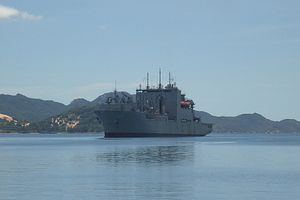A third U.S. Navy ship visited Vietnam’s newly-opened port facility in the Southeast Asian state in a reminder of the ongoing collaboration between the two countries in the maritime realm.
The Arleigh Burke-class guided missile destroyer USS Mustin (DDG 89), which is on patrol from Yokosuka, Japan with a crew of 300 sailors, arrived in Cam Ranh International Seaport, a new international port facility capable of receiving foreign warships which was opened in March (See: “Vietnam Unveils Port Facility For Foreign Warships in Cam Ranh Bay”). The port, located in Cam Ranh Bay, a deep-water harbor in central Vietnam along the South China Sea that Washington had used as a base during the Vietnam War, has since seen visits from a string of countries, including Japan, France, China, the Philippines, and Singapore.
The USS Mustin is the third U.S. Navy ship to visit Cam Ranh International Port this year. Two U.S. ships had visited in September in the first interaction of this kind since the Vietnam War, and the visit occurred after a Naval Engagement Activity (NEA) (See: “US, Vietnam Boost Naval Cooperation with NEA 2016”). Though the United States refers to its naval interactions with Southeast Asian states such as the Southeast Asia Cooperation and Training (SEACAT) and the Cooperation Afloat Readiness and Training (CARAT) as exercises, those with Vietnam continue to be referred to on their own as a Naval Engagement Activity (NEA).
The visit of the USS Mustin this week is “a technical visit” that is mainly “for crew rest and cultural exchange,” Arlo Abrahamson, public affairs officer at the U.S. Seventh Fleet’s Task Force 73, which helps plan and execute exercises and engagements, emphasized to The Diplomat.
But there is no doubt that the engagement is nonetheless significant for U.S.-Vietnam defense relations. In 2012, former U.S. Defense Secretary Leon Panetta had said that access for U.S. naval ships to Cam Ranh Bay was “a key component” of the U.S.-Vietnam relationship. And as I noted earlier this year, since the opening of the port facility in March, U.S. and Vietnamese officials had indicated that the idea of U.S. vessels visiting would be realized by the end of the year, even though the specifics, including the number of visits, their nature, and the exact timing, would be determined carefully (See: “US-Vietnam Defense Relations: Problems and Prospects”).
During their stop this week, sailors from the USS Mustin would have a chance to meet with people from Nha Trang, where the port is located, share U.S. culture through sporting events, and learn about Vietnam through local cultural activities.
“The USS Mustin’s stop in Cam Ranh International Port is an example of the depth of our comprehensive partnership and the importance of strengthening our civilian and military ties,” U.S. Ambassador to Vietnam Ted Osius said.
The United States and Vietnam upgraded their relationship to a comprehensive partnership back in July 2013. The relationship received another boost this year with U.S. President Barack Obama’s visit to Vietnam, which strengthened ties including in the defense realm, with the lifting of a decades-old arms embargo.

































